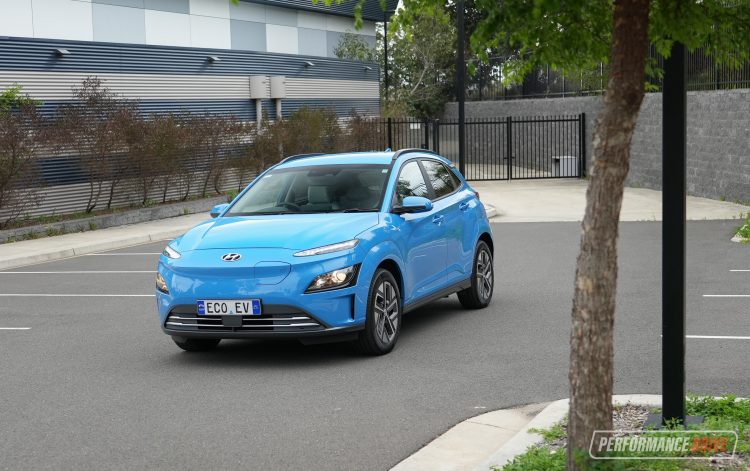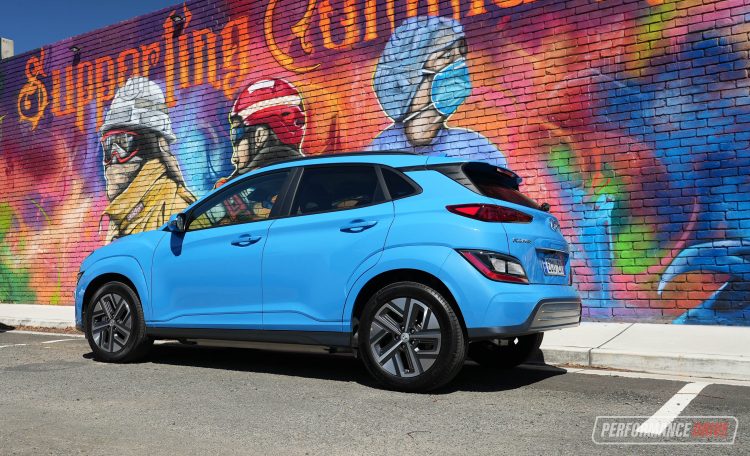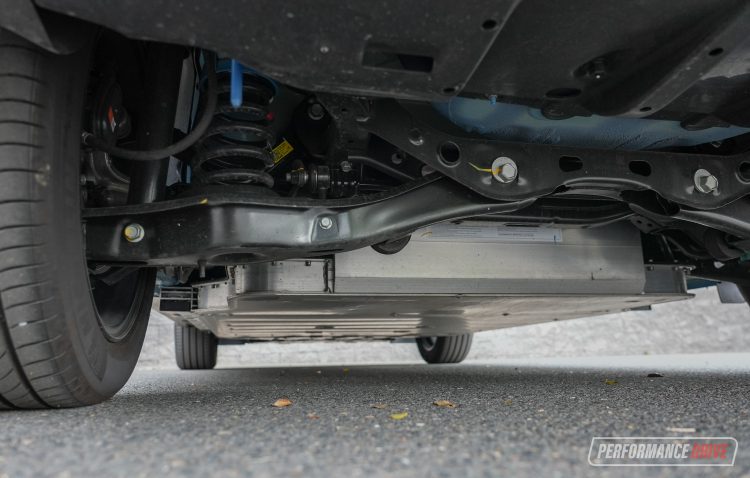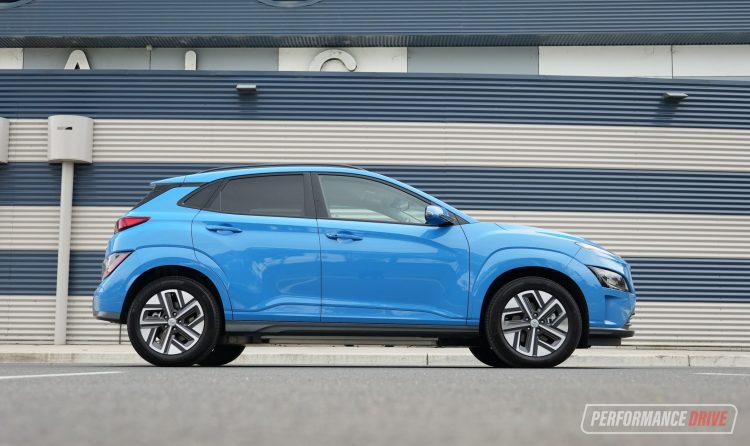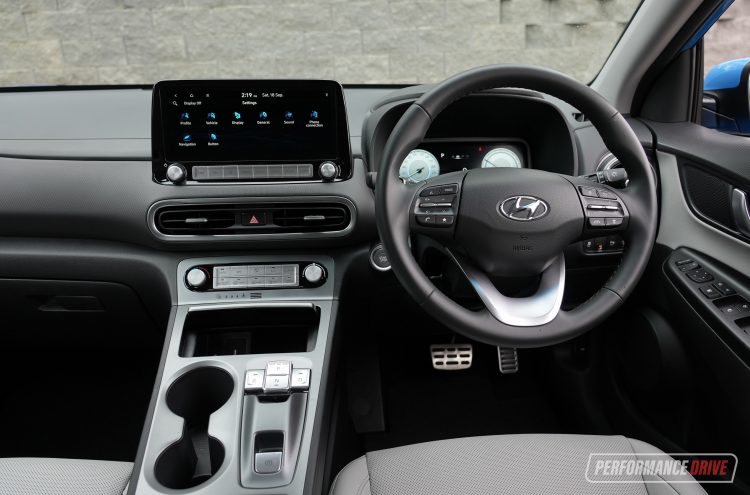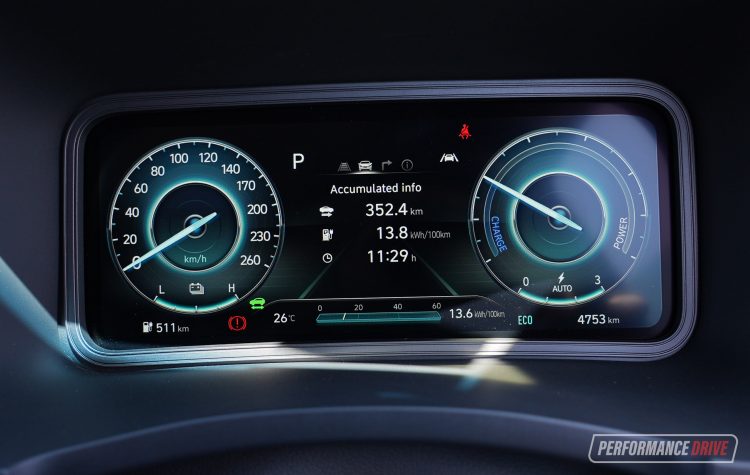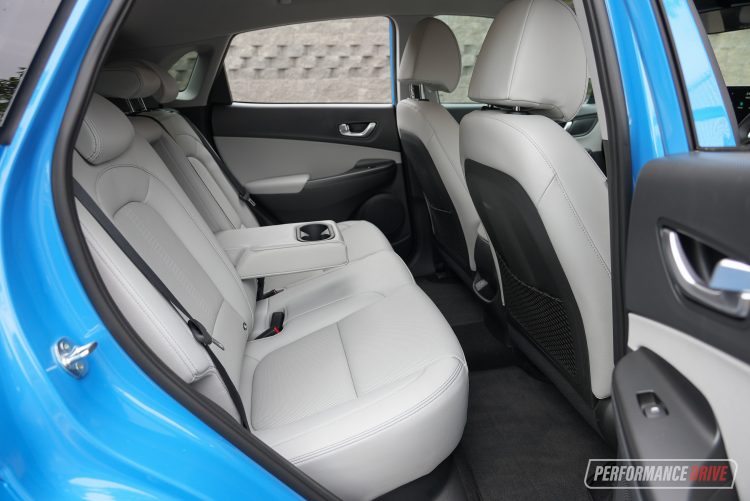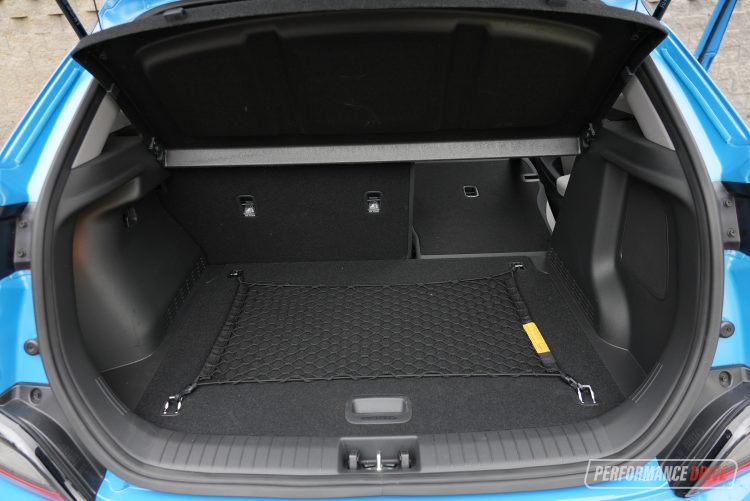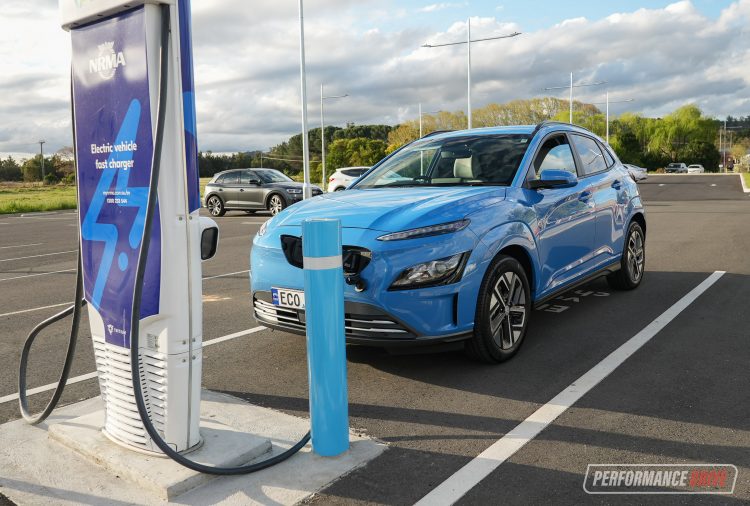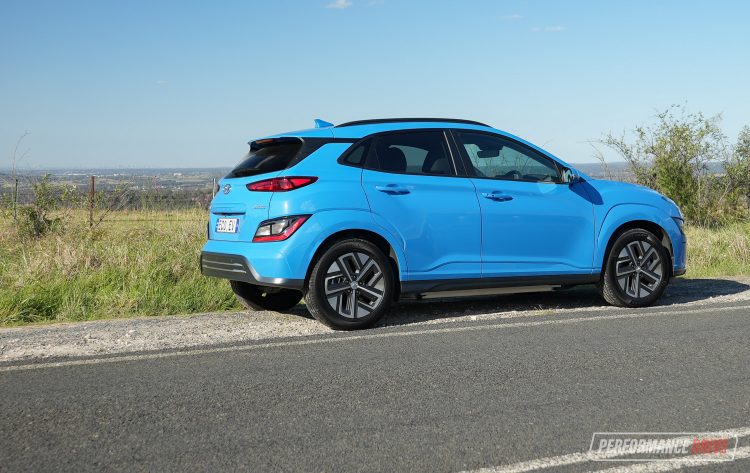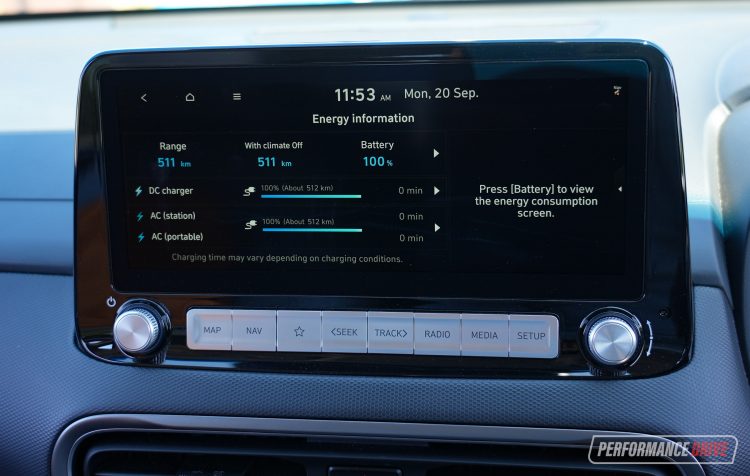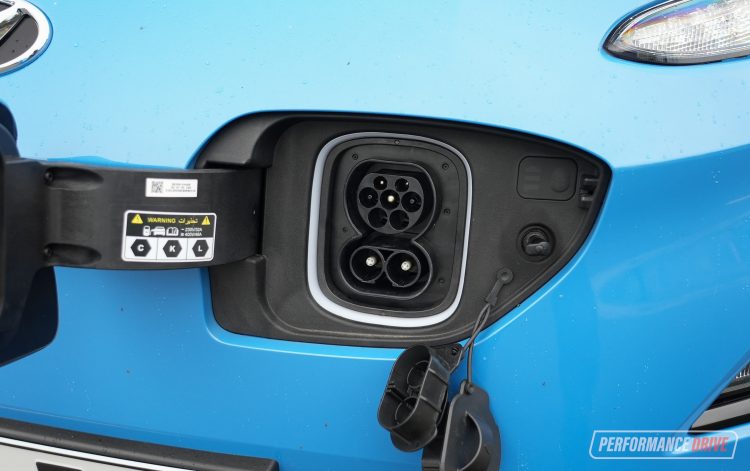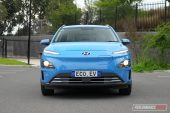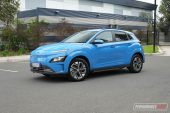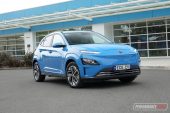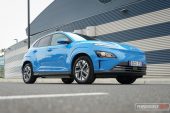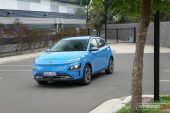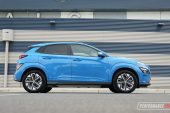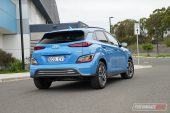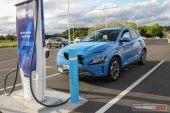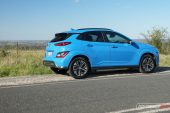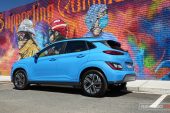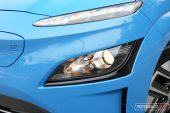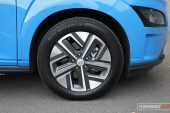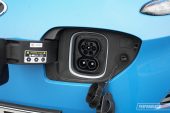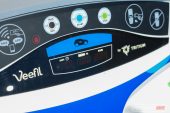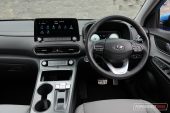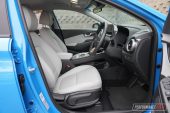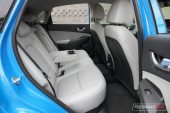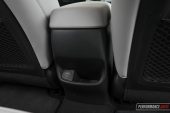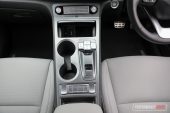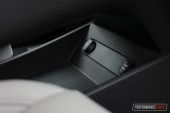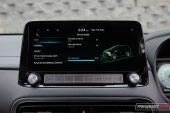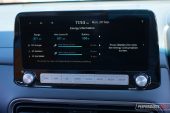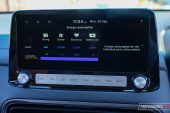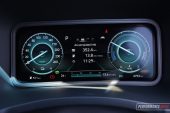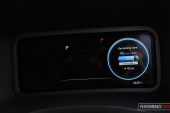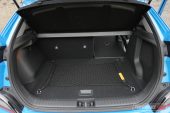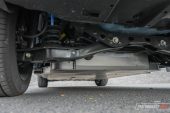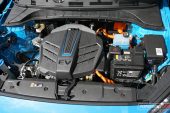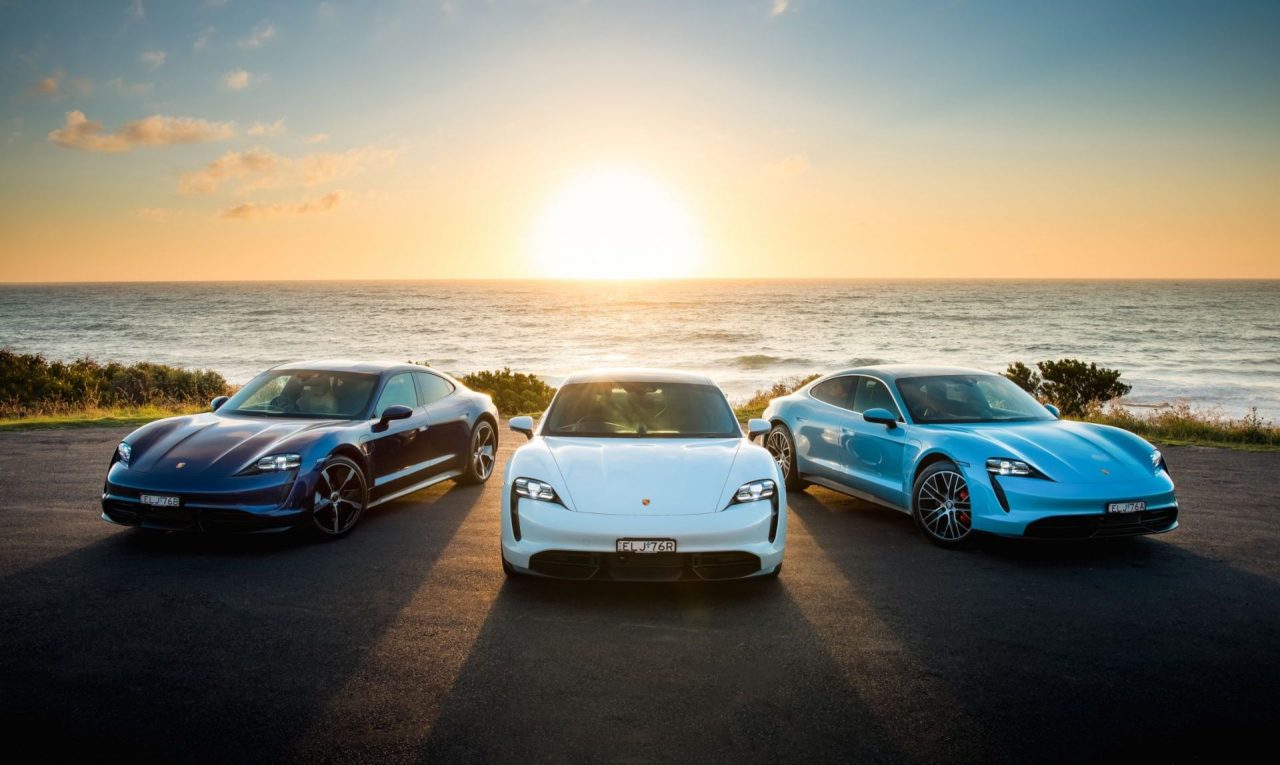The thing with entry-level electric vehicles is, they tend to be pretty boring to drive, driving range is usually pretty low and they are often much more expensive than their petrol-powered counterparts. Can the 2022 Hyundai Kona Electric prove us wrong?
Well, to get the first potential issue covered, the Kona Electric is not promising to be an exciting sports car. It is simply an electric version of an existing practical and user-friendly SUV. In other words, the expectations should not be very high in the area of overall driving enjoyment and entertainment. However, it is the most powerful and quickest model in its class.
What about the price then? Prices remain quite high for what it is. And it’s not just the Kona Electric – most rivals are pricey too. For example, this Elite variant we’re testing here starts from $60,500. That’s way more than the Kona Elite petrol, which starts from $31,600. And even if you account for the additional luxuries and features presented in the Electric Elite over the petrol Elite, the turbo-petrol Kona N Line Premium starts from $42,400. Heck, even the Kona N high-performance model kicks off from $47,500. So what’s the go? Every time we speak to a carmaker about EV prices they always blame the costs associated with battery production and materials supply.
EVs have been around for quite a few years now and a lot of materials actually come from right here in Australia. Surely they can work out more cost-effective measures by now? Especially if they want to present products in the same market segment as much more affordable petrol models. The fact that you end up saving money in the long run due to never having to pay for fuel isn’t really justified, as that is not the manufacturer’s concern and it is not an area where they can make money anyway.
As for our other concern about range? Well, this innocent nameplate actually boasts one of the highest ranges on offer in Australia at the moment, and easily surpasses all of its key rivals.
2022 Hyundai Kona Electric Elite – THE SPECS
[column width=”47%” padding=”6%”]Electric system: 65kWh battery, 356 volts
Output: 150kW / 395Nm
Transmission: One-speed auto; 7.981:1
Drive type: Front-wheel drive
Wheels: 17 X 7.0, 215/55
ANCAP: Five stars
Tare weight: 1743kg
Power-to-weight: 11.62:1 (kg:kW)
Range: 484km (WLTP)
Recharge time: 100kW: 47min (10-80%), 50kW: 64min (10-80%)[/column] [column width=”47%” padding=”0″]0-60km/h: 3.54 seconds*
0-100km/h: 6.77 seconds*
60-110km/h: 4.33 seconds*
1/4 mile: 14.96 seconds at 156.1km/h*
Max acceleration: 0.688g
100-0km/h braking: 3.05 seconds at 38.30 metres*
Max deceleration: -1.102g
Decibel at idle (standby): 25*
Peak decibel at 60-100km/h: 70*
Priced from: $60,500[/column][end_columns]
* Figures as tested by PerformanceDrive on the day. Factory claims may be different
2022 Hyundai Kona Electric Elite – THE PACKAGE
The 2021-2022 model is the first facelift for the Kona Electric. And as with the first version introduced in 2019, the 2022 model is just as practical and user-friendly as the regular petrol-powered Kona models. Only now, thanks to a new set of tyres, the range has been increased from 449km to 484km on the WLTP cycle. Using the ADR/NEDC cycle the range is a very impressive 557km.
That gives it significant bragging rights; it is the highest range you’ll find in an entry-level EV in Australia at the moment, easily overshadowing all of its closest rivals: Kia Niro (455km), Mazda MX-30 EV (200km) and MG ZS EV (263km – or 439km in updated 2022 form).
The updated design gives it a sleeker, smoothed-over front end, but aside from that, it looks pretty much the same as the first model. The size and proportions are pretty much identical to the regular petrol-powered Kona, too. However, underneath, this gets the multi-link rear suspension setup which is only featured on the all-wheel drive versions of the petrol model. Such a setup is renowned for superior dynamics and handling over a conventional torsion-beam arrangement.
You can see the big battery pack mounted under the floor, which contributes to a reduction in ground clearance by 19mm over the regular petrol Kona Elite (from 177mm to 158mm). You can actually see the battery pack, or at least the construction supporting it, just by looking at the side of the vehicle. Even though the petrol Kona is hardly a proud and proven off-road vehicle, it is worth noting the ground clearance if you do capitalise on the raised stature of SUVs and crossovers during your regular journeys.
Also new for the updated model is a set of freshly-designed 17-inch alloy wheels. We think they look nice, and they don’t scream and shout ‘I’m an eco car’. These now feature Michelin Primacy 4 215/55 eco-focused tyres, compared with the previous Nexen tyres (same size). Not only do the Michelins provide a bit more grip in the corners and during acceleration and braking (according to our Vbox tests), they also increase the official range, as mentioned.
The interior maintains its blend of practicality and user-friendliness, with a liberal dose of premium feel. Considering this is the Elite variant and not the top-spec Highlander, it presents very well and actually comes across as a luxury-targeted atmosphere. And we guess it should for a 60-grand small SUV.
Up on the dash is Hyundai’s latest 10.25-inch touch-screen system featuring Android Auto and Apple CarPlay, supporting digital radio and a rear-view camera, and it comes connected to an eight-speaker sound system.
The driver views another 10.25-inch screen, which, due to its straight-forward rectangular design and emotionless housing, looks quite sterile and uninteresting in our opinion. The graphics are pure and crisp however, and the different colour themes go well with the different drive modes.
We like the additional storage around the centre console on the EV compared with the petrol models. Since there is no conventional transmission underneath or a series of mechanical gear selector rods, the centre console floats, leaving a big storage tray underneath. It features separate charging ports.
There’s also a wireless phone charger up on the main console, as well as dual cup holders and a decent-size centre box and arm rest in the middle. The driving position provides a clear view outward, but it would be nice if the seat could adjust to a lower setting.
Rear seat space remains pretty tight for this segment, as with the regular Kona, and it’s a shame there are no rear climate vents in the back of the centre console. But there is a charging port and phone holder, as well as cup and bottle holders. Going for the Highlander variant adds a sunroof which could help to open up the perception of space when opened.
You do have to sacrifice some boot space in the electric model over the petrol models. In Elite trim, for example, this offers 332L or 1114L with the rear seats folded down, while the petrol Elite offers 374 litres or up to 1156 litres. There is some under-floor storage here and a cargo net to keep items secure.
2022 Hyundai Kona Electric Elite – THE DRIVE
Power continues to come from a 64kWh/356V battery system, which feeds a single 150kW/395Nm electric motor at the front axle. It actually looks like a normal engine when you lift the bonnet, at least on first glance. Being the second most powerful Kona in the showroom, behind the 206kW Kona N, the available performance here is very impressive. We clocked 0-100km/h in a best of 6.77 seconds using our Vbox Sport, beating our previous time of 6.86 seconds in the old model with Nexen tyres.
Leaving the traction control on is a must otherwise it is very easy to fry the front tyres. During testing on a private road we stomped on the throttle from standstill with the traction off just to see what it would do. With 395Nm available as quickly as you can depress the pedal, and with only 215-wide tyres, it spun both front wheels for about 20 metres along the dry tarmac, non-stop. In fact, it started to grab traction after about 30 metres, by which point the vehicle was travelling at around 70km/h. No, this isn’t a 700hp muscle car we’re talking about. This is an eco-friendly small SUV.
Sure, not many buyers are going to want to drive around in this manner, and nor do we recommend it on public roads. But out on a windy road it is fun getting close to the traction threshold as you escape corners. Even with the systems left on you still get hints of wheelspin. Sometimes you hear a surprising chirp during ‘kickdown’, for example. During our 60-110km/h test we tried it with the traction control off, and yep, sure enough, it started lighting up the front tyres. Roll-on wheelspin from a practical small SUV? This thing is a sleeper. You can see all of this in action in our demo video below.
Around corners the Kona Electric does feel a bit heavier than the petrol Kona. Because it is heavier. 390kg heavier, actually, at 1743kg versus 1353kg in the petrol Elite. That’s a lot. However, most of this weight is positioned low down which helps to keep the centre of gravity low. What’s that mean?
Think about somebody trying to push you over while you stand on two feet. Now imagine somebody trying to push you over while you sit with crossed legs on the ground. It’s going to be a bit harder for them isn’t it? That’s kind of how a lower centre of gravity is better in a car. The average mass is lower down, resulting in less body roll and lean, which usually results in agility and enjoyable handling.
Tie that in with instant power and big torque, and you have yourself quite an entertaining vehicle to drive. And as described at the start of this review, driving fun is not intended to be a standout feature of its repertoire. It is just an electric SUV, remember. You find yourself really admiring its ‘under-promise, overwhelm’ character.
As for the eco side of things, the full charge range according to the dash readout is 511km. Unlike many EVs we’ve driven in recent times, this range is actually achievable in the real world. You can use the ‘paddle shifters’ to alter the three-stage regenerative braking pressure to help optimise range as well. For example, leave it in level 1 during an uphill stint on a mountain drive, and then click up to level 3 during the downhill sections and during braking to maximum your on-board recharging. You can also play around with various vehicle functions to maximise range if you want to.
Sure, there are some EVs on the market that are much quicker, but they tend to go through the battery level rather quickly, the more you push it. Like a V8 guzzler. Whereas here it doesn’t seem to matter as much because it seems to be more powerful than it needs to be. If that makes sense. You only need about 25 per cent throttle to keep up with busy traffic, or apply 50 per cent and you’ll easily swoop past other motorists. Again, it is a sleeper in that sense. An unassuming fighter. A wolf in sheep’s clothing.
Charging can be done via a Type 2 or CCS2 socket thanks to a clever removable cap on the vehicle. This is great as one of the big problems with EVs in Australia at the moment is the limited number of public charging stations, let alone finding a station with the right socket. Another thing that could help is to have an additional charging plug on the other side of the car (perhaps at the rear corner). We’ve seen it on the Porsche Taycan with a plug on both front guards. Having the option there can be very handy. Again, mainly due to the limited number of charging stations in this country – some require certain parking positions.
2022 Hyundai Kona Electric Elite – THE VIDEO
2022 Hyundai Kona Electric Elite – THE VERDICT
Personally, I quite like cars that are modest yet over-achieve. I like that this is just a regular Kona, which is already a decent product for what it sets out to be. Except this is fitted with an electric motor. That’s it. No overpromises, no weird or awkward design themes (mostly) or overly-complicated driving skills needed. But, in reality, it is the most powerful/torquiest EV in its class, the quickest, and it offers the longest range. Can’t argue with that.
In the real world you can totally achieve the WLTP-rated 484km range, or even find more if you use the paddle shifters to work the regenerative braking to its advantage. It’s clearly fast enough for a small, practical SUV – faster than some performance SUVs in fact – and it is enjoyable to drive and just as easy to drive as the regular Kona. Our only concern is the price. Around $20,000 more than the flagship petrol-powered Kona is just way too much to ask.
[column width=”47%” padding=”6%”]PROS:
– Achievable 484km range
– Fun and easy to drive, just like regular Kona
– Class-leading power and torque
– Class-leading performance
– Two charging socket types (Type 2 and CCS2)
[/column] [column width=”47%” padding=”0″]CONS:
– About $20,000 more than petrol Kona is a big ask
– Kona rear seat and boot space falls behind some rivals[/column][end_columns]
As always, if you’re thinking about buying a new car don’t forget to click here to speak with our car buying specialists.
